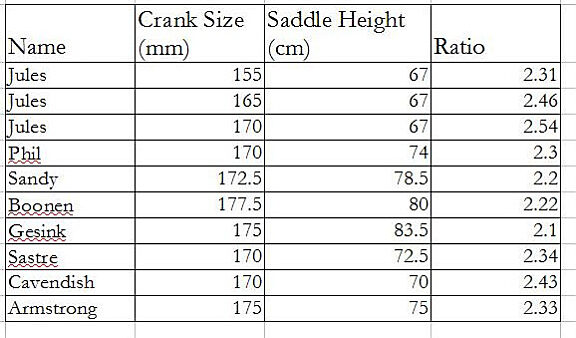I started cycling over twenty years ago, for the first few years I had no idea what crank length I used but as I continued in the sport and purchased my first mountain bike I began to know a little more about the machine I was riding.
I have the dubious honour of having virtually the shortest legs in the peloton but have for most of my cycling life used standard 170mm cranks on my road bike and 175mm on my mountain bike.
I have been fitting riders to bikes for nigh on fifteen years and wrongly assumed that bike and component manufacturers knowledge is superior to mine, after all they have been doing it longer. At Cyclefit we design custom frames to be millimetre perfect but generally use cranks that vary in length by only 0.5cm for customers whose inseams range from 75cm to 93cm.
What we are aware of at Cyclefit is that bike manufacturing is an industry and for a company to survive it must make a profit therefore reducing the number of products it produces and has to warehouse the better.
Most bike manufacturers now only produce five frame sizes to cater for the population as opposed to eight or nine ranging from 48cm to 62cm. We are now categorised as either extra small or large or medium/large etc. Across this range of frame sizes cranks were specced usually in three sizes 170mm, 172.5mm and 175mm, much easier for component manufacturers then to only make three crank sizes and why not stop making triple chainsets as well so inventory is reduced and we have to struggle up mountains in a 34/28 gearing.
After a season of trying to ride up mountains and hours of both physical and mental self-analysis in September I decided to reduce my crank size in proportion to my leg length. 155mm in fact.
The main reason for the change was that at the point of maximum torque in the pedal stroke a short leg will be bent more and the sheering stresses at the knee greater. This became very apparent as I struggled up the Tournmalet in the summer at about 3rpm.
Would a more open knee angle through the dead spot at the top of the stroke and maximum torque further down the stroke reduce the sheering stress and the amount of force required to move the pedal?
We based our calculations on the average saddle height of average sized riders who would normally use 170mm or 172.5mm cranks, worked out the ratio of leg to crank (not including feet) and used this to decide which size cranks to use. It is not fool proof because femur length and foot size also get involved but the actual difference of 1.5cm is a good place to start because the body will need plenty of time to adapt to such a major change.
See table below:
Initial impressions were:
- Less pressure/discomfort on the knee at the start of the down stroke.
- More space at the top of the pedal stroke between upper leg and torso. this is not only because the crank is shorter but also because there is more space for the foot to dorsiflex on the up-stroke. Easier to pedal in the saddle going up hill.
- Legs less stiff walking down stairs in the morning!
- Acceleration quicker in the saddle.
- Riding in the drops easier.
After three months use I can add the following:
- Muscle fatigue is reduced and I can ride five consecutive days per week to work where as my legs would be tired after three days with the 170mm cranks (I am no fitter).
- Right knee less sore.
- Less irritation in my left SIJ.
- The distance my pedals and feet now travel around the bottom bracket in an hour compared to a 170mm crank at the same cadence is less (approximately 0.5km on my commute), therefore the the distance my muscles travel when contracting and extending is less and therefore fatigue (my theory).
- It feels like the quads are working more closer to the knee than rather than in the middle of the femur.
- The cranks feel normal.
Unfortunately I have had the opportunity to ride up any mountains yet, Mallorca will be the first climbing test and in the mean time I will get some 'power' data.
Unfortunately I have had the opportunity to ride up any mountains yet, Mallorca will be the first climbing test and in the mean time I will get some 'power' data.
Climbing?
I haven't climbed anything substantial yet but…the picture below illustrates a 10% gradient and because a rider has a centre of gravity it is natural to tip forward on the bike to maintain this on a steep gradient. The handlebar drop is reduced as the bike travels up hill and this combination results in a reduced angle at the hip; shorter cranks help maintain an open hip angle which aids leg tracking integrity for riders with a limited hip inflexion range
But what about power?
Well there is less torque generated by a shorter 155mm crank (so I'm told) but more force is required to drive a 170mm crank for two reasons: shorter levers i.e. legs and feet and a reduced angle at the knee.
I can subjectively say that one balances out the other. Riding over wet grass for instance at a lower cadence is no harder than with longer cranks.
Where the shorter crank is noticed is when a surge is required to increase speed, where in the past I would click up a couple of gears and push down hard I now increase cadence before changing up, but there is less need to get out of the saddle.
Short cranks and Triathlon position
Steep seat angles and forward saddle positions are it seems improving pedalling bio mechanics for triathletes and David Green of Elite Cycles has always advocated shorter cranks for triathletes 'Pedal fast, run fast' he would say - a shorter crank encourages use of a lower gear and higher cadence.
If you compare the length of my run stride to that of some one who is 5'10" for instance the difference would be more than the 2.5mm than in the suggested crank length difference found on most bikes. A shorter crank length for the shorter triathlete will give all the above benefits and more, as less leverage will encourage a higher cadence saving their legs for the run.
A lower aero bar position is achievable as knee tracking at the top of the stroke is improved.
The knee over pedal axle for a triathlon position can be three or four centimetres in front of the pedal axle, but no there is no account taken of how far the knee is in front of the bottom bracket and more importantly how far behind on the upstroke?
A shorter crank for the triathlete means the legs will be less extended behind the bottom bracket and pelvis on the upstroke allowing the foot to dorsiflex a little more and the leg will be flexed less at the top of the stroke. This closer resembles the action of running and could reduce the difficult adaption period at the start of the run.
This is work in progress and as you can see quite subjective..


